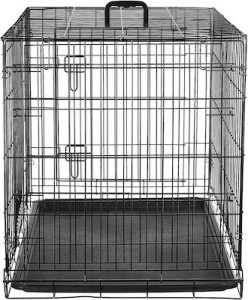Dogs can be a great addition to the family. But, it’s not always relaxing walks, cuddles, and easy going. In fact, dogs can be a lot of hard work, especially when puppies or in the adolescent stage. During this stage, your dog may test you.
They will test the boundaries, and could even regress towards negative behaviours such as mouthing, biting, jumping up, or generally being too over excitable. If your puppy or dog is testing the waters, and your patience, then it could be an idea to try the time out method.
So, what is a dog time out, how do you do it, and is it okay to give your dog time outs? Let’s find out.
What Is A Time Out?
A time out is the term used for social isolation. It is a type of negative punishment. While we typically use positive reinforcement to train our dogs, sometimes it is useful to use something that the dog enjoys such as social interaction with us, and take this away from them to reduce unwanted or negative behaviour.
In a time out, you will need to take the dog and put them in their own space, such as a crate, (if they like crates) or their bed. In other cases, you can place them in an area such as behind a baby gate where they cannot get to you. Or, you can leave the room briefly for them to calm down.
The Right Way To Do Dog Time Outs
Time outs are great for behaviours that are self reinforcing, meaning that the dog enjoys doing it, and it feels good. This could be digging, barking, or biting. Ignoring them, or positive reinforcement doesn’t always work for these behaviours. If you have tried everything else, try a time out.
The right way to do this is to remove the dog from the environment and their access to you for a short period of time as a direct response and consequence of the behaviour. This will teach the dog that unacceptable behaviour has a consequence.
To implement a time out, you’ll need to choose two verbal commands centred around the behaviour. For instance, if you have a dog that barks, choose ‘Quiet’ or ‘That’s Bad’. Keep these commands consistent. So, when your dog starts barking, say the first command: ‘Quiet!’.
If they continue to bark, then use the second command ‘That’s Bad’, and immediately but calmly remove the dog from the environment, and take them to their crate, or a small room where you can confine them alone. This won’t make a negative correlation between the crate and the dog, as long as they typically like the space.
Then, leave your dog in the crate for between 30 seconds to 2 minutes. Once quiet for about 30 seconds to a minute, take them back out of the crate. If they begin barking again, repeat the process.
Once you’ve done this a few times consistently, your dog will start to understand that if they do not listen to the first command, they will be confined to a small space for a time out. Then, when they stop barking after the first behaviour, be sure to positively reinforce with high value treats.
This is not a quick fix. You will have to repeat the time outs consistently every time your dog repeats the behaviour without listening to your command to stop. They will make the correlation eventually.
How Long Should You Put Your Dog In A Time Out?
The answer to this ultimately depends on the dog in question, and what the time out is being used for. As a general rule, time outs should not last more than two minutes, as dogs cannot understand or comprehend if it is used as a punishment. They are social animals, and some may not do well when left alone without anyone.
If using time outs for the first time, then start with 30 seconds, and move upwards towards two minutes once your dog is more used to them. If you leave them for too long, they will forget which behaviour has caused this consequence, and they won’t learn anything.
In addition, a time out has to be implemented immediately after the action, in order for the dog to understand it has a consequence. There is no use putting them in a time out if you’ve left them home alone and they’ve chewed something hours ago. They won’t know why they have been put there.
Is It Okay To Put Your Dog In A Time Out?
Yes, it’s perfectly fine to give your dog a time out. This can be an effective and efficient way to train your dog, and to limit unwanted behaviours. As long as you implement the time outs effectively, and do not cause unnecessary stress on the dog, then this method can help you set some boundaries between you and your dog.
Final Thoughts
If you’re at your wits end with your dog’s negative behaviour, then you could try time outs. When done correctly, this is an effective way to reduce these behaviours in a humane, safe, and stress free manner.





